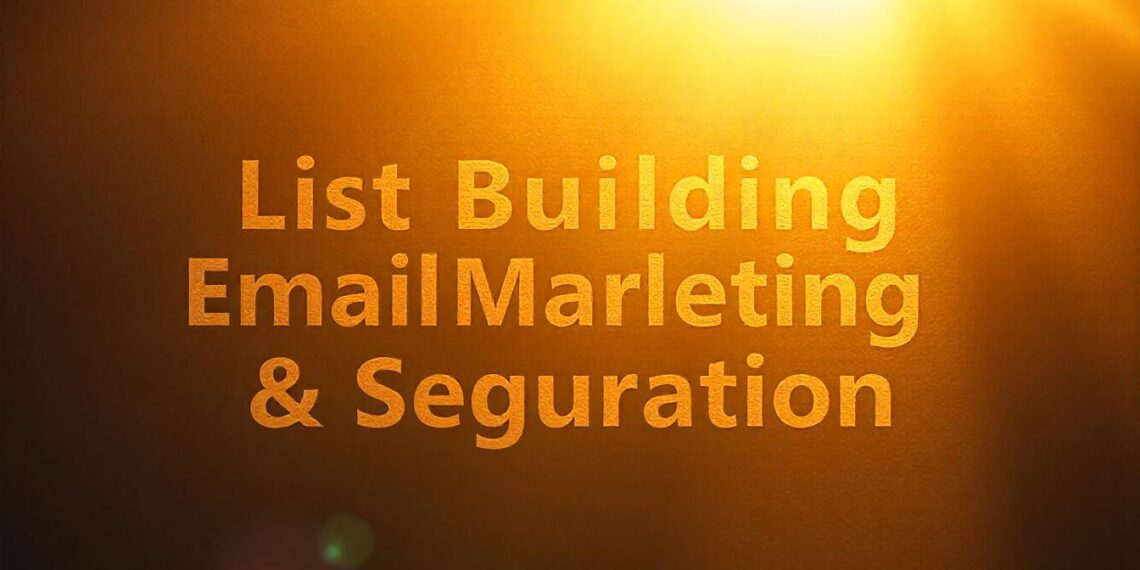In today’s digital world, email marketing remains one of the most effective channels to connect with audiences, drive conversions, and nurture relationships. However, the real magic lies in not just sending emails, but in building a high-quality email list and segmenting it strategically. This allows marketers to send personalized, targeted messages that resonate with each subscriber, increasing engagement and ultimately, conversions. Here’s how to effectively build and segment your email list for better targeting.
The Importance of a Strong Email List
A quality email list is essential for any marketing strategy. Unlike social media followers, an email list consists of individuals who have willingly given their contact details, showing an interest in what you offer. Building a strong email list is the foundation of effective email marketing. It’s not just about quantity; focusing on quality ensures you have engaged subscribers who are more likely to respond positively to your campaigns.
Benefits of a Strong Email List
- Higher engagement: Subscribers who opt into your list have shown an interest, which means they’re more likely to open, read, and interact with your emails.
- Increased conversions: With a targeted email list, you can personalize messages based on customer preferences, making it easier to convert leads into customers.
- Improved deliverability: A well-maintained list avoids common pitfalls such as high bounce rates and unsubscribes, which can harm your sender reputation and reduce deliverability.
How to Build an Email List
Building an email list requires more than simply asking for email addresses. Here are some effective techniques to grow your list organically and create a strong foundation.
Offer Incentives and Value
People are more likely to share their email if there’s something valuable in return. Offer incentives such as discounts, exclusive content, free resources, or access to a special community. These rewards create a win-win situation, as subscribers receive something useful, and you gain an engaged contact.
Use High-Impact Sign-Up Forms
Optimize your sign-up forms to capture attention and make it easy for users to subscribe. Keep the form fields minimal, usually just a name and email address, and clearly state what subscribers will receive by joining your list. Placement is crucial; consider using pop-ups, slide-ins, or embedding forms in strategic areas like the homepage, blog posts, and at checkout.
Leverage Social Media
Your social media audience is an untapped pool for building your email list. Use your social platforms to promote the benefits of subscribing to your list. Offer exclusive updates, sneak peeks, and content that only subscribers can access, driving your followers to take the next step and sign up.
Host Webinars or Events
Live webinars, virtual workshops, and events are excellent ways to capture email addresses. Participants are typically interested in your niche, making them prime candidates for your email list. During registration, make sure to include an option for attendees to sign up for your email list.
The Power of Segmentation
Segmentation is the process of dividing your email list into smaller, more targeted groups based on specific characteristics. Segmented campaigns drive better engagement than non-segmented campaigns because they address the unique interests and needs of each group.
Why Segment Your List?
Segmentation allows for more personalized and relevant messages, which leads to:
- Higher open and click-through rates: Emails tailored to specific interests are more likely to be opened and clicked.
- Lower unsubscribe rates: When subscribers receive content relevant to them, they’re less likely to unsubscribe.
- Better conversion rates: Targeted messages help guide subscribers more effectively along the buyer’s journey, increasing the likelihood of conversion.
Key Methods of Segmenting an Email List
Effective segmentation goes beyond basic demographics. Here are some powerful ways to segment your email list:
1. Demographics
Demographic segmentation involves grouping subscribers based on factors like age, gender, location, and income level. This approach helps tailor your messages to fit the specific lifestyle or interests of each group.
2. Behavioral Segmentation
Behavioral segmentation targets subscribers based on their actions, such as:
- Purchase history: Tailor emails to customers based on past purchases, promoting complementary products or offering loyalty rewards.
- Browsing activity: If a subscriber has shown interest in certain products or pages, you can send emails related to those products.
- Engagement level: Segment by how often subscribers open or click on your emails. This can help you re-engage inactive subscribers with special offers or send more frequent updates to highly engaged subscribers.
3. Interest-Based Segmentation
Allow subscribers to choose their preferences when signing up. For example, a fashion brand could let users select the types of clothing or accessories they’re most interested in. This preference-based approach ensures each subscriber receives content that aligns with their tastes, increasing the likelihood of interaction.
4. Lifecycle Stage Segmentation
Segmenting by where a subscriber is in the customer journey helps you deliver content that’s more relevant to their current stage:
- New subscribers: Send welcome emails to introduce your brand and build trust.
- Leads: Offer educational content or promotions to encourage first-time purchases.
- Repeat customers: Show appreciation through loyalty rewards and exclusive offers.
- Inactive customers: Create win-back campaigns to re-engage these subscribers with targeted offers or reminders.
5. Geographic Segmentation
For businesses that operate in multiple regions, geographic segmentation is invaluable. You can tailor emails to address regional preferences, seasonal events, and location-specific promotions, making your messages more relatable and timely.
Implementing and Optimizing Segmentation Strategies
Implementing segmentation in your email marketing strategy involves careful planning and regular optimization. Here’s a step-by-step approach to get the best results.
Step 1: Analyze Your Audience Data
Start by gathering data on your subscribers through analytics, surveys, and tracking. Review their demographics, behaviors, interests, and preferences. This information serves as the foundation for creating meaningful segments.
Step 2: Set Clear Goals for Each Segment
Every segment should have a clear purpose and a unique strategy. For example, a segment of new subscribers could receive a welcome series, while frequent buyers might get loyalty discounts. Defining goals helps you create targeted content that resonates with each group.
Step 3: Personalize Your Content
Segmentation is most effective when paired with personalized content. Use dynamic content to change certain aspects of an email based on the recipient’s profile. For instance, you can personalize the greeting, product recommendations, or even the subject line based on the segment’s attributes.
Step 4: Test and Measure Results
A/B testing is essential for optimizing segmentation efforts. Test different strategies within each segment, such as email frequency, subject lines, and content formats. Monitor metrics like open rates, click-through rates, and conversions to identify what works best for each group.
Step 5: Regularly Update Your Segments
As your audience grows and changes, so should your segments. Subscribers may move from one lifecycle stage to another, or their interests may shift. Regularly review and update your segments to ensure your campaigns remain relevant and effective.
The Role of Automation in Segmentation
Email marketing automation simplifies the segmentation process by automatically categorizing subscribers based on real-time behaviors. For example:
- Triggered emails: Send automated emails based on specific actions, such as abandoned cart reminders or birthday messages.
- Drip campaigns: Set up a series of automated emails that nurture leads through the sales funnel, delivering relevant content at each stage.
- Dynamic segmentation: Use AI and machine learning tools to constantly evaluate and update segments based on evolving subscriber behaviors.
Automation not only saves time but also ensures that each subscriber receives timely and relevant content without manual effort, enhancing engagement and conversions.
Conclusion: Building and Segmenting for Success
Building a strong email list and segmenting it effectively is essential for driving targeted, successful email marketing campaigns. By focusing on quality, creating value, and using strategic segmentation, businesses can reach their audience with messages that resonate. Through regular analysis, personalization, and automation, you can refine your efforts, maximize engagement, and turn email marketing into a powerful tool for business growth.






